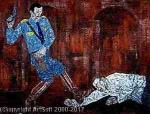Leon Golub
Leon Golub
yer: Chicago
Doğmuş: 1922
Ölüm: 2004
Biyografi:
Leon Golub was an American painter. He was born in Chicago, Illinois, where he also studied, receiving his BA at the University of Chicago in 1942, and his BFA and MFA at the Art Institute of Chicago in 1949 and 1950, respectively.
He was married to and collaborated with the artist Nancy Spero (1926 – October 18, 2009). Their son Stephen Golub is an economics professor at Swarthmore College. Their son Philip Golub is Professor of International and Comparative Politics at the American University of Paris and was a longstanding contributing editor of the influential journal Le Monde diplomatique. Their youngest son Paul Golub is a theater director and acting teacher working in France.
Born in Chicago in 1922, Golub received his B.A. in Art History from the University of Chicago in 1942. From 1947 to 1949 he studied under the G.I. Bill at the School of the Art Institute of Chicago (SAIC). The student body included a large number of vets, including Golub’s one-time flatmate Cosmo Campoli, George Cohen, Theodore Halkin and Seymour Rosofsky, whose work often reflected the horrors of war, as well as the uncertainties of the Cold War and Nuclear age. It was at SAIC that he met the artist Nancy Spero, to whom he was married for nearly fifty years. Golub helped organize and showed in the seminal Momentum Exhibitions of 1948–1949, organized by SAIC and Institute of Design students in protest over their exclusion from the Art Institute’s prestigious "Annual Exhibition by Artists of Chicago and Vicinity." He was also featured, along with Campoli, Halkin and Rosofsky, in the Art Institute’s "Veteran's Exhibition" of 1948. The group included, in addition to Golub’s aforementioned classmates, June Leaf, H.C. Westermann, Irving Petlin, Evelyn Statsinger, Don Baum, and Arthur Lerner.
In Chicago, Golub became involved with other artists collectively dubbed the "Monster Roster" by critic Franz Schulze in the late 1950s, based on their affinity for sometimes gruesome, expressive figuration, fantasy and mythology, and existential thought. They believed that an observable connection to the external world and to actual events was essential if art was to have any relevance to the viewer or society. This is a view that informed Golub's work throughout his career.
Golub, and the group, gained notice in the 1950s when art historian and curator Peter Selz featured him, Campoli and Cohen in a 1955 ARTnews article, "Is There a New Chicago School?", and included him, Campoli and Westermann in the 1959 Museum of Modern Art (MoMA) exhibition, New Images of Man, as examples of vanguard expressive figurative work in Europe and the United States. In later years, the Monster Roster would be regarded as forerunners to the more widely known Chicago Imagists.
Golub, who always painted in a figural style, drew upon diverse representations of the body from ancient Greek and Roman sculpture, to photographs of athletic competitions, to gay pornography; often pulled directly from a huge database he assembled of journalistic images from the mass media. He likened his painting process to sculptural technique and employed a method of layering and scraping away paint, sometimes using a meat cleaver, leaving varying amounts of canvas untouched.
From 1959 through 1964, Golub and his wife Nancy Spero opted to live in Europe, a move occasioned in part by the belief that Europe would be more receptive to their work dealing overtly with issues of power, sexual and political. During this period Golub's work increased in size because of larger available studio space and the inspiration of the French tradition of large-scale history painting. He also switched from using lacquer to acrylics, left more of the surface unpainted, and began to grind the paint directly into the canvas. While in Italy, both Golub and Spero were profoundly influenced by the figurative works of Etruscan and Roman art, whose narratives addressed ancient themes of power and violence.
When Golub returned to New York State, the Vietnam War was escalating, and he responded with his two series: Napalm and Vietnam. He and Spero became active with Artists and Writers Protest, "the first such group to take a public stand against the war". In 1967 as part of the group's Angry Arts Week, Golub organized The Collage of Indignation, a collaborative work by over 150 artists which he described as "not political art, but rather an expression of popular revulsion."
In the mid-1970s, Golub was beset with self-doubt. He destroyed or cut up many works he produced up to this period and nearly abandoned painting. In the late seventies, however, he produced more than a hundred portraits of public figures, among them political leaders, dictators, and religious figures. Leon Golub: Paintings, 1950-2000 includes several portraits of Nelson Rockefeller and Ho Chi Minh, along with images of Fidel Castro, Francisco Franco, Richard Nixon, and Henry Kissinger.
More...
Wikipedia link: Click Here

